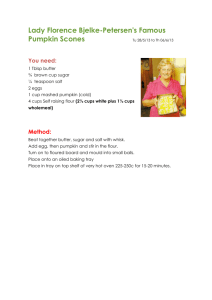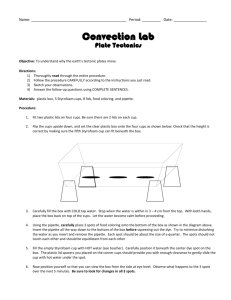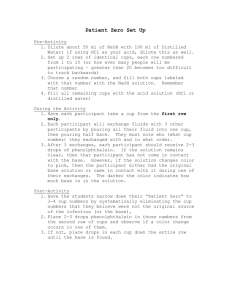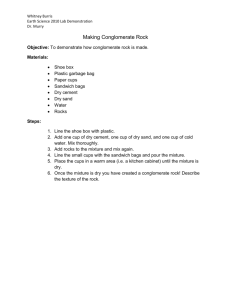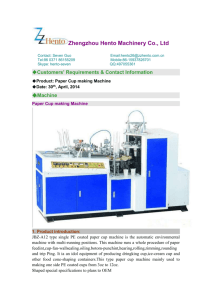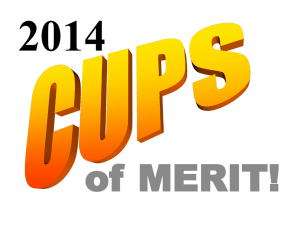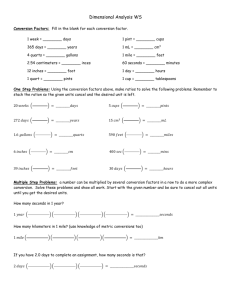OCEAN PRESSURE LAB: Styrofoam Cup Squishing
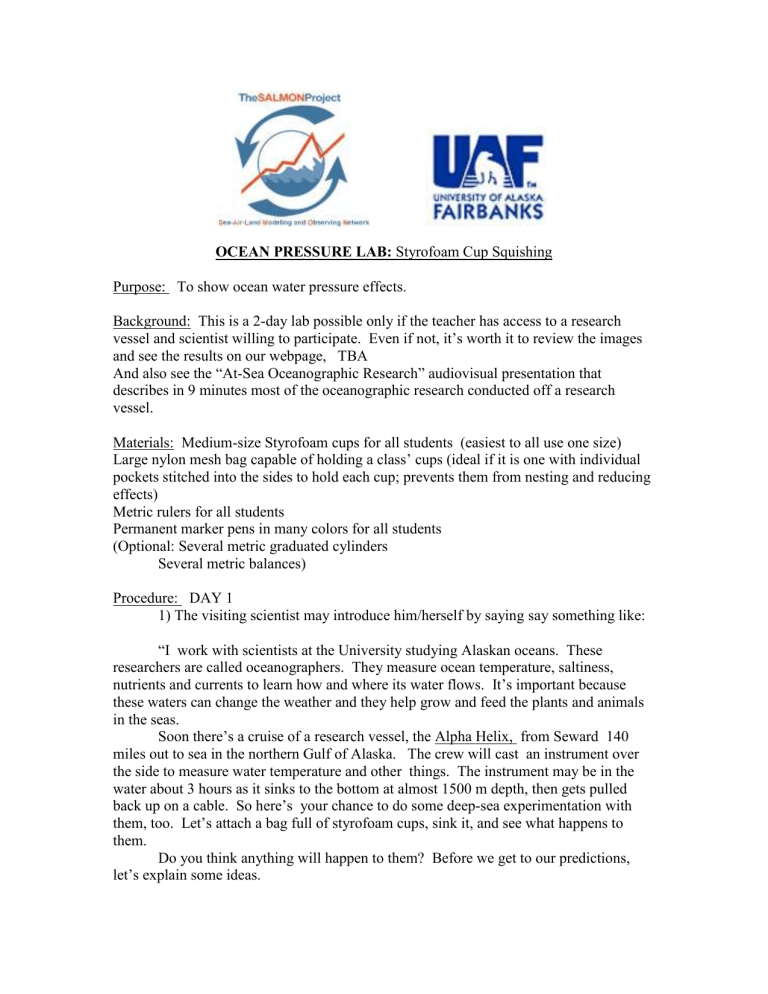
OCEAN PRESSURE LAB: Styrofoam Cup Squishing
Purpose: To show ocean water pressure effects.
Background: This is a 2-day lab possible only if the teacher has access to a research vessel and scientist willing to participate. Even if not, it’s worth it to review the images and see the results on our webpage, TBA
And also see the “At-Sea Oceanographic Research” audiovisual presentation that describes in 9 minutes most of the oceanographic research conducted off a research vessel.
Materials: Medium-size Styrofoam cups for all students (easiest to all use one size)
Large nylon mesh bag capable of holding a class’ cups (ideal if it is one with individual pockets stitched into the sides to hold each cup; prevents them from nesting and reducing effects)
Metric rulers for all students
Permanent marker pens in many colors for all students
(Optional: Several metric graduated cylinders
Several metric balances)
Procedure: DAY 1
1) The visiting scientist may introduce him/herself by saying say something like:
“I work with scientists at the University studying Alaskan oceans. These researchers are called oceanographers. They measure ocean temperature, saltiness, nutrients and currents to learn how and where its water flows. It’s important because these waters can change the weather and they help grow and feed the plants and animals in the seas.
Soon there’s a cruise of a research vessel, the Alpha Helix, from Seward 140 miles out to sea in the northern Gulf of Alaska. The crew will cast an instrument over the side to measure water temperature and other things. The instrument may be in the water about 3 hours as it sinks to the bottom at almost 1500 m depth, then gets pulled back up on a cable. So here’s your chance to do some deep-sea experimentation with them, too. Let’s attach a bag full of styrofoam cups, sink it, and see what happens to them.
Do you think anything will happen to them? Before we get to our predictions, let’s explain some ideas.
How many of you can swim? How many of you can swim under water? What do you notice when you dive to the bottom of the pool?” (Student response: “PRESSURE
ON YOUR EAR”) “What’s pressing in on your ears?” (WATER) “So we call it water pressure.
Your cups in the bag experiment will be dragged to a depth of 1500 m or 3.28ft/ m x 1500m= 4920ft. That’s almost 5000 ft of water pressing down on these cups when they reach the bottom. Wonder how that affects them?
To answer that, how about if you pressed down on them right here?” (YES,
THEY’LL SQUISH!)
“So your pressing down on things is called pressure. It’s measured in what units?
If you think about bicycle tire pressure, maybe that will help you answer.
Let’s see if we can figure it out. The pressing down is just our push down or, in the case of the ocean, the water pushing down on whatever object is submerged in the water . We could measure the amount of pushing down with a weight scale. That reads in what units of measurement?” ( POUNDS )
“And the pressing down always has to be against something. How could we measure the size of the surface we’re pressing against? How do you measure how much surface you have? Using a ruler to measure how big the desk top is, you’d measure what and what? “(LENGTH AND WIDTH) “Which give you ?” (SURFACE AREA ) “ And we measure surface area in what units?” (SQUARE INCHES.) “So therefore, pressure is weight compared to the surface area it’s pressing against and it’s measured in lbs per sq in.”
“Back to ocean water pressure. It turns out that for every 33 ft of water depth we go down, the pressure increases by almost 15 pounds per sq in (psi). There’s more water piling up and pressing down more heavily as we go deeper. If we’re sending the cups down 4920 ft, then how much pressure in lbs/ sq in is on them? Take 4920 ft divided by
33 ft is 149. So we multiply 149 times 15 psi increases which gives us a total increase of
2236 psi. Imagine 2200 lbs on you; this is more than a ton. It’s a lot or pressure!
Now that you have more information about our experiment, what sort of predictions can you make about what may happen to these cups when they go for a dive?
And now let’s measure your cup, record this data on the lab sheet (see attached), and draw some artwork, name or symbols on the cup so that you can identify it as your own. Then we’ll have the measurements to see how much it changed, if at all, when I return the cups to you.”
2. Hand out cups.
3.
With rulers, demonstrate the cup measurements.
4. Use an overhead transparency of the lab sheet to demonstrate how to record data.
{OPTIONAL: 5. For volume, just fill up to the brim a Styrofoam cup, then pour liquid into this fancy measuring cup called a graduated cylinder and read how many ml or what it’s capacity is.
6. “The last column is __________? “ (DENSITY). “It’s written that its units are ____________? “(G/ML). “This arrangement tells you what?” (THEY”RE A
COMPARISON. ) “We’re comparing g to ml. And mathematically, what’s this mean?
What title directions are written there in that column?” (DIVIDE. WHICH MEANS A
COMPARISON OF MASS TO VOLUME)
7. Finish calculations with calculator.}
8. “Here’s an example that may help explain how density is different from weight. Take 2 roll-of- film canistors. Holding them up, it’s clear they occupy the same volume. How about their masses?” Hand them to a student to hold and sense their weight. “One’s heavier than the other.” Explain by opening and showing it’s full of quarters. “How else can you describe a comparison of the 2 containers without using the words weight, mass or heaviness? One’s denser. It has the same volume, but a different weight (or mass).”
9. “Your teacher will keep your sheets for when I return. Then we shall see and remeasure what the ocean pressure may or may not have done to your cups.”
Day 2: 1. Gather rulers and calculators for students.
2.
Redistribute lab sheets.
3.
Hand out cups to respective students.
4.
Calculate changes and percentage changes after showing students examples how to do it on the overhead.
Discussion: Percentage changes to linear dimensions run around 63% decrease, or that cup height or diameter have reduced by 2/3rds from its original dimensions. And if the cups haven’t nested in the bag but stayed separate, then their compression should be uniform in all directions since forces are transmitted equally in all directions in a fluid.
This uniform compression should show up clearly in some artwork, ie a realistic, recognizable drawing should be equally reduced in both height and width. An actual to scale measured grid labeled with size and units can be remeasured for the uniform shrinkage.
Sources: Duxbury, A.C., and Duxbury, A.B., 1991, An Introduction to the World’s
Oceans, 3 rd
edition, W.C. Brown, Dubuque, see pg.124.
OCEAN PRESSURE LAB:
Name:________________________ School:____________________
Grade:________ Teacher:______________________
Date
Cup
Height, centimeters
(cm)
Top
Diameter, cm
What’s your marker pen design:
Date
Cup
Height, cm
Top
Diameter, cm
What happened to your design:
Change in Change in
Top Cup Height, cm [1 st measurement minus 2 nd
]
Diameter, cm
Mass, grams (g)
Mass,
g
Change in
Mass, g
Volume, milliliters
Volume, ml
Change in
Volume, ml
Density, g/ml
[divide mass by vol]
Density, g/ml
Change in
Density, g/ml
% Change in Top
Diameter
%
Change in Mass
%
Change in
Volume
%
Change in
Density
% Change in
Cup Height
[change divided by 1 st measurement, then times
100]
PLEASE TURN OVER
1. Why’d we do this experiment?
2. What did we do?
3. What happened?
4. What do you think caused the changes? How ?
5. So what’s the most significant finding to come from this lab?

